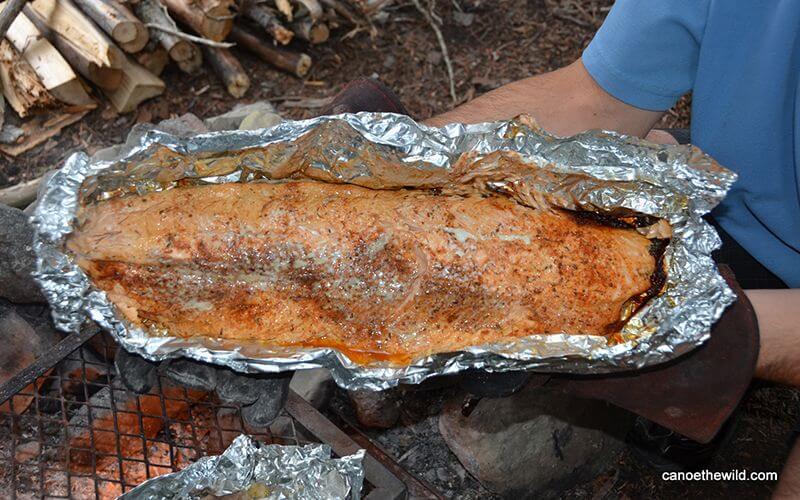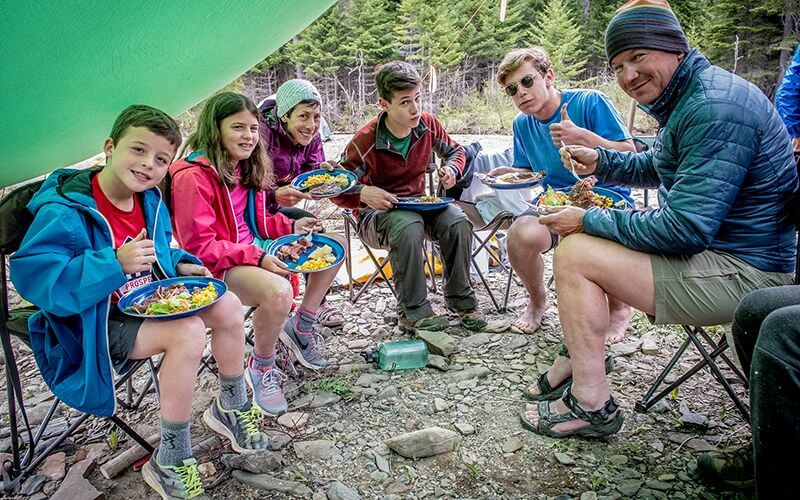Meal Planning for Your Next Canoe Trip
One really nice thing about canoe camping is the amount of space you have in a canoe for carrying food supplies, including a cooler. A 70-quart cooler fits nicely in the center of an Old Town 169 Discovery Canoe which is 35” wide at the beam. Canoe camping makes it easy to plan a menu that includes fresh fruits, vegetables, meats & dairy. When planning for an extended trip (five days or longer), plan your menu for your fresh meats, fish, salad ingredients to be consumed early on, and your frozen foods for later in the trip up to seven days (seven days only if you have perfected using your cooler and know firsthand how long your ice will last). Last summer, our ‘freezer’ cooler lasted 8 days on our NE Mistissibi Canoe Trip in Quebec and that was 2 days with temperatures reaching into the middle 80s!
MEAL IDEAS FOR CANOE TRIPS
Dinners consist of locally raised rib-eye steaks, wild caught salmon, pork loin, spaghetti with homemade sauce, taco soup, chicken, rice, vegetables & dumplings. Served with dinner are fresh salads/slaws, vegetables, rice pilaf, fresh baked biscuits and baked desserts including brownies & strawberry shortcake. Breakfasts include organic coffee, assortment of regular & herbal teas & hot chocolate, rolled oats, fruit, buttermilk pancakes served with real Maine blueberries & syrup, french toast, ploys, and the traditional Maine guide breakfast of local farm fresh eggs, meat and organic potatoes. Lunches are on the fly and may include make your own wraps with assorted breads, variety of meats and cheeses, tuna, lettuce, pickles & tomatoes. Snack foods including trail mix, beef jerky, carrots, peanut butter, bars, cookies, fruit. For trips that require food beyond the life of your ice, plan on meals such as taco soup, lentil chili or spaghetti with meat sauce using dehydrated hamburger. Chicken and rice with dumplings using canned chicken and mac and cheese with canned ham. For lunch, use canned meats which may include ham, chicken, salmon and tuna along with peanut butter and jelly. For breakfast, canned meats can be served along with pancakes, hot cereal and buckwheat ployes.

PACKING A COOLER FOR CANOE TRIPS
Depending on your climate and how well you maintain your coolers, it is not uncommon to plan frozen foods for up to a week. We choose inexpensive, well insulated coolers over the pricy, heavier thick-walled, bulky coolers as these don’t fit well and take up valuable space in the canoe. With larger canoe groups, use two coolers and place in separate canoes, one for your fresh foods including cheeses, cold cuts, butter, milk, eggs, cool whip and meats you’ll use up over the first three days and a second cooler as your freezer for extended trip foods including frozen meats such as steaks, fish, pork loins, bacon, sausage & burger, and liquid eggs in a carton. Use frozen gallon sized water jugs over block ice. This keeps your cooler drier as block ice makes for a mess in the bottom of the cooler as it melts. During pre-trip food preparations, be sure to remove food items from their original packaging and place is a doubled-up Ziploc bag, especially with meats to prevent juices pooling up in the bottom of your cooler. Cut out cooking directions from original packaging and include with the packed food items or use a sharpie with portions and basic directions on how to prepare and cook. Assign one person (preferably the one who planned the menu and packed the cooler) for retrieving items from the cooler so as to prevent the cooler from being opened too many times. Be organized, pack you cooler with items you will use near the start of your trip at the top and items you’ll use later in the trip near the bottom. Always be sure lids are securely shut to prevent ice from melting too quickly. You’ll be surprised how quickly ice melts when something is caught in the lid preventing the cooler from being sealed shut.
When arriving at your campsite, be sure to place cooler is a shaded location out of the direct sun. Another way to keep your ice longer, is to drape a wet white towel over your cooler. As the towel dries it creates a convection effect cooling your cooler. Re soak the towel as needed. While on whitewater canoe trips secure your cooler using a strap made of rubber, much like a large rubber band that goes around the girth of the cooler. This keeps the lid firmly shut even if the canoe and cooler end upside down in the river! To make a rubber cooler strap, secure a spent inner tube from a large farm tractor. Here in Maine, an inner tube from a logging skidder tire will work well for this. To make the strap, simply cut a cross section out about 2” wide out of the inner tube. On calmer trips, instead of an inner tube strap, we often use river straps with a cam buckle around the cooler that can be attached to your gunwale or thwart.
For trips with lengthy portages such as Webster Stream, the East Branch of the Penobscot and when taking part in shorter sections of the Northern Forest Canoe Trail, you’ll want to skip the bulky cooler and go with a soft pack with shoulder carry or back pack style straps. I just purchased 2 deluxe food packs from Cooke Custom Sewing, these durable soft packs are made for canoe camping, have nice shoulder carrying straps and are lined with closed cell foam. We’ll use these packs as produce packs for fruits and vegetables and on shorter canoe trips with long portages as a cooler. While most produce does not need refrigeration, we often place a 2-quart frozen jug a water wrapped in newspaper so as to prevent direct contact with certain fruits & vegetables which can ruin them. On shorter trips with lengthy portaging, I’ll use a smaller soft pack to include steaks, breakfast meats, meat for sauces, cold cuts & sliced cheese. It sure is nice on a guided canoe trip to use these types of foods verses canned, freeze dried or dehydrated options.

STORING NON-COOLER FOODS ON CANOE TRIPS
While there are many options for storing and transporting foods on canoe trips, I like to use 30-liter blue recreation barrels, not only are they water and bear proof, these smaller containers can be distributed amongst the canoes easier (verses large heavy bulky boxes), strapped or tied in with little worry about losing you food in the event a canoe upset.
COOKING FOOD ON CANOE TRIPS
Here in the Northeast, we do almost all of our cooking over an open fire. You’ll want to research your planned river trip to find out what the regulations are when it comes to open fire and cooking. For example, while the Green River Float Trip in Utah’s Ashley National Forest provides campsites that include picnic tables, benches, tent pads and a fire ring for campfires, the Grand Canyon River Trip in the Grand Canyon National Park requires bringing a stove for cooking and has strict guidelines on fires for warming and aesthetics.
BAKING DESSERTS AND BISCUITS
Reflector ovens are quite common but can be bulky to transport unless they are of the collapsible kind. We use food grade aluminum Dutch oven style rectangle baking dishes. This style nestles and stores much easier than the traditional Dutch oven pot which is also quite heavy. First, we preheat the top and bottom over the open fire and remove some coals and place them on a level area. Next, place the bottom section on the coals (no flame to prevent burning), add oil (to prevent sticking) and ingredients. Next place the lid over the top and build a twig fire on the lid. Depending on what you are cooking, biscuits often take about ten minutes while brownies 20 minutes or longer. These baked dishes can be extremely hard to find and we do have a contact in New Brunswick, Canada for these bake style dishes (contact Dave for more info).
While there are certainly many great food options for canoe camping that do not require the use of a cooler and cooking over a campfire, it sure is nice to take advantage when possible by expending your options while on a canoe camping trip.
Testimonial of a Canoe the Wild Guest
“The food was carefully prepared and was delicious! It is amazing what Tammi made for main course and Andrew taught us how to bake on an open fire. Madeline and I baked chocolate cake with chocolate frosting!” -Carrie West, Seattle Washington, 2018 Allagash Canoe







